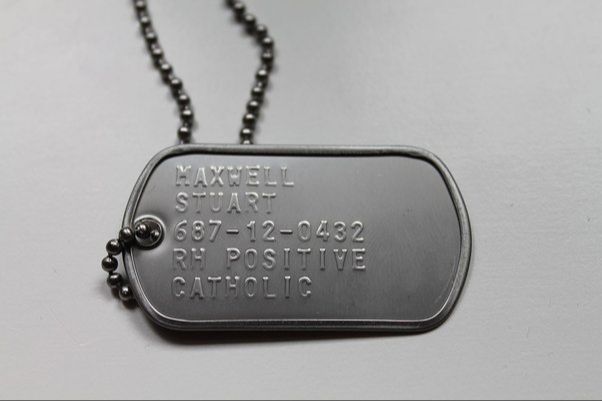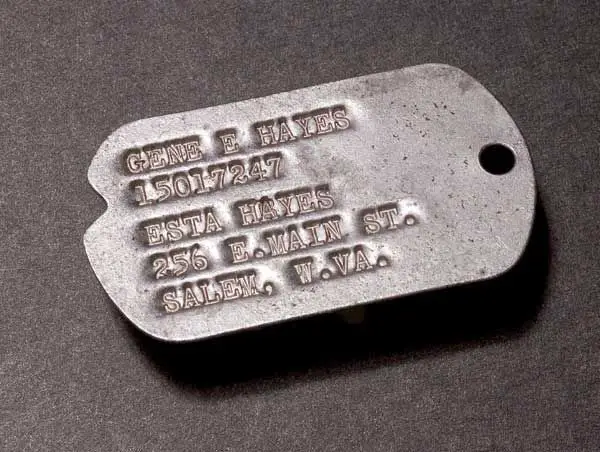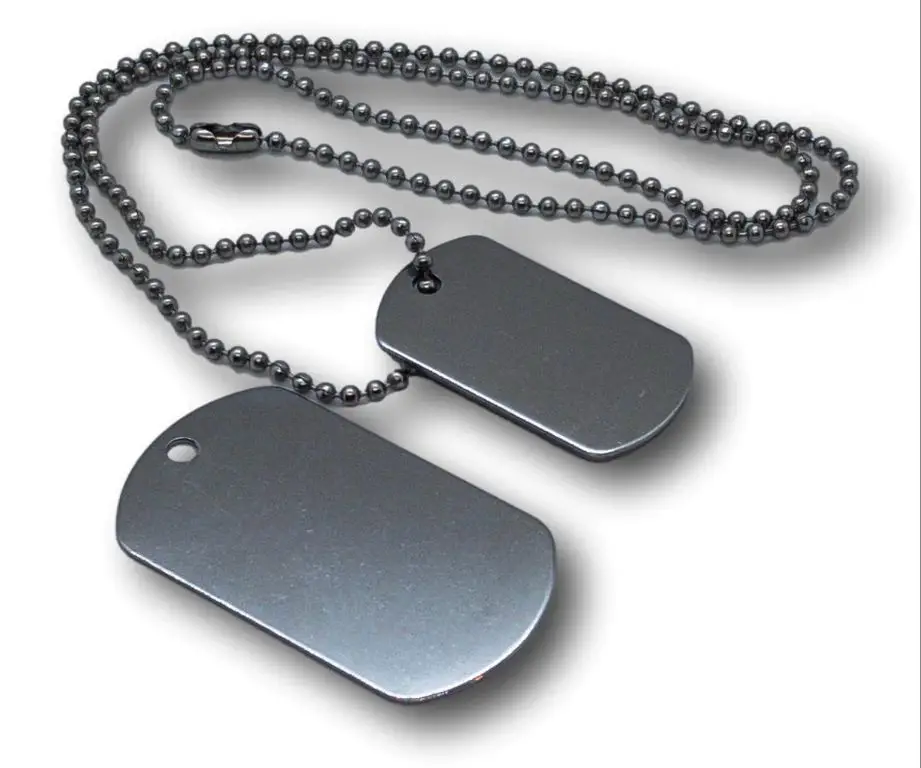Introduction
Dog tags are worn by soldiers for identification purposes. They contain personal information such as the soldier’s name, rank, service number, and blood type. The origins of military dog tags can be traced back to the Civil War era when some soldiers pinned paper notes with their name and home address to the backs of their coats before battle. This was so their bodies could be identified if they were killed. The practice became more widespread during World War I. The name “dog tags” comes from the tag’s nickname, “dog collar”.
This article will provide an overview of the history and purpose of military dog tags. It will cover when soldiers receive dog tags, what information is included on them, proper wearing and safeguarding of tags, whether soldiers can keep their tags after service, the collectible value of vintage tags, dog tags in pop culture, and modern changes to military dog tags.
Purpose of Dog Tags
Military dog tags serve two main purposes. First, they help identify deceased soldiers in combat. The tags provide critical personal information including the service member’s name, Social Security number, blood type, and religious affiliation. This allows the deceased to be identified quickly on the battlefield and returned to their families for proper burial. According to Operation Military Kids, dog tags earned their nickname for the way they would drape around a fallen soldier’s neck. The grim purpose of swiftly identifying the dead has remained central to their function over the years.
Second, dog tags provide medical personnel with vital health information in emergency situations where a service member is unconscious or unable to communicate. The religious affiliation indicates whether the individual has any restrictions on medical treatment. The blood type allows medics to perform life-saving transfusions when needed. Overall, the dog tags supply critical details to help give proper treatment to injured soldiers.
When Soldiers Receive Dog Tags
The standard issue of dog tags in the U.S. Army occurs upon enlistment, during the initial entry training that takes place at either basic training or boot camp. This is when new recruits receive their first set of official dog tags.
Typically two copies of dog tags are made for each soldier. As explained on the U.S. Department of Defense website, having two dog tags allows one to stay with the soldier, while the other can be collected if the soldier is killed in action. This ensures quick identification and helps notify next of kin.
[Source: https://www.quora.com/During-your-service-in-the-US-Army-when-do-you-get-your-dog-tags]

What’s on Dog Tags
Dog tags contain essential identification and medical information for soldiers in case of an emergency. Standard dog tags typically include the following:
- Name and service number – Dog tags list the soldier’s full name and service ID number for identification purposes.
- Blood type – Knowing a soldier’s blood type is critical for providing proper medical treatment, so this is prominently displayed.
- Religious affiliation (optional) – Soldiers can choose to have their religious preference listed on their dog tags. This is helpful for chaplains.
- Allergies or medical conditions – Dog tags may note any important medical conditions or medication/food allergies. This helps ensure proper treatment.
Having this key information immediately available allows medical personnel to quickly identify a soldier and provide appropriate care if injured. Dog tags are designed to be durable and readable in emergency situations. Custom Dog Tags
Wearing and Safeguarding
Soldiers are required to wear their dog tags at all times while in the military according to military regulations. This is for identification purposes in case something happens to the soldier in the line of duty. According to one Reddit user on r/Military, soldiers must wear their dog tags even when sleeping.
Soldiers are responsible for safeguarding their dog tags and keeping them in good condition. The tags should not be damaged or defaced. Soldiers are advised to tuck their dog tags into their shirt to avoid damage during training or combat. Replacement dog tags can be issued if the original set becomes lost, stolen or damaged beyond use.
Can Soldiers Keep Tags After Service?
Usually, soldiers are allowed to keep their dog tags after being honorably discharged from the military (1). This is because dog tags are considered the personal property of soldiers, even though they are issued by the military during active service. After discharge, soldiers are no longer required to wear or use their dog tags, as the tags primarily serve to provide vital identification information in combat or active duty situations.

However, there are some exceptions where soldiers may not be able to keep their dog tags. In classified or covert missions, soldiers may be required to surrender their dog tags to protect sensitive information. The tags could reveal details about the mission or unit that need to remain secret. In these cases, the military may collect or destroy the dog tags after the mission to preserve confidentiality (2).
So in most cases, soldiers do get to keep their dog tags as meaningful mementos after honorable discharge from the military. The tags remain their personal property and aren’t required to be returned. But for sensitive missions, dog tags may be confiscated or destroyed to protect classified details.
Sources:
(1) https://veteran.com/replacement-dog-tags/
(2) https://www.usamm.com/blogs/news/replacement-dog-tags
Collectible Value
Historic dog tags from major wars like World War II and Vietnam hold significant interest for collectors and military history enthusiasts. Many American families have ancestors who served in these wars, making their dog tags prized family heirlooms. Museums, collectors, and history buffs also seek out WWII and Vietnam dog tags as tangible mementos of the soldiers who fought in those conflicts.
Dog tags from famous historical figures fetch extremely high prices at auction. For example, a WWII dog tag belonging to baseball legend Ted Williams sold for over $1,000. Museums like the National WWII Museum in New Orleans have displays of dog tags from soldiers who served in every military branch.

Beyond museums, people display military dog tags in shadow boxes, cases, and displays as decorations and tributes to relatives or historical figures who served. Custom engraved dog tags are also popular gifts and keepsakes for active duty and veteran service members. Dog tags represent the sacrifices of soldiers, making them highly valued as historic memorabilia and military collectibles.
In Pop Culture
Dog tags have become a well-recognized symbol of military service, frequently featured in films, TV shows, books, and other media. They often serve as visual shorthand to identify a character as being in the military. For example, Lt. Dan wore actual Vietnam veteran Gary Sinise’s dog tags in the film Forrest Gump (1994) to establish his character as a wounded Vietnam vet.[1] Many war and military-themed movies prominently feature dog tags, like Saving Private Ryan, Platoon, Hurt Locker, etc. They have become embedded in pop culture as icons of military service and sacrifice.
Modern Changes
In recent years, there have been some modern updates to the traditional stamped metal dog tags worn by soldiers. One significant development is the testing of digital dog tags by the military. For example, in 2021 the company Smart Tags LLC developed a high-tech wearable called the Multi-Domain Operations (MDO) Wearable that resembles traditional dog tags but contains electronic components like sensors to monitor a soldier’s vital signs (https://www.popularmechanics.com/military/research/a37598240/smart-dog-tags-mdo-wearable/). The goal is to provide commanders with real-time data on a soldier’s status during combat situations.
Another change is utilizing laser etching instead of the traditional embossing stamps to imprint the text and numbers on dog tags. Laser etching allows for cleaner and more durable markings. Companies like CIM now provide laser etching equipment to military facilities around the world.

Conclusion
In summary, dog tags have a long history of identifying soldiers in the U.S. military. While styles and tags issued have evolved over the years, their purpose remains the same – to provide critical identification information in the event a soldier becomes a casualty. Though the advent of technology like DNA testing has reduced the reliance on dog tags, they remain an iconic part of a soldier’s gear and are still issued today. The tradition and military culture around dog tags make them an important part of a soldier’s service.
While regulations restrict active duty soldiers from keeping their dog tags, veterans are allowed to retain them as mementos of their service once discharged. Dog tags are miniature records of a veteran’s time in the military and as such, hold sentimental value and are often passed down. They also have collector appeal due to their historic nature. In closing, while the process of issuing dog tags has modernized, they remain an important military tradition that lives on in the culture and memories of those who have served.
